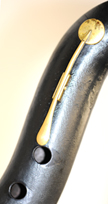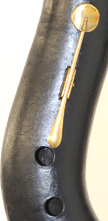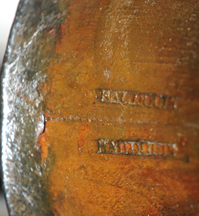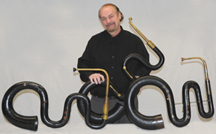

 hurch
hurch  erpent in C by Baudouin
erpent in C by Baudouin
Serpents made by Baudouin are now considered the finest instruments of the 19th century. Originally from Belgian, Baudouin maintained a workshop in Paris during the early 19th century through the 1830s where he constructed keyless and keyed serpents d’eglise. The early 19th century keyless Baudouin serpent, owned by Christopher Monk, became the model for the Monk Workshop instruments.
This Baudouin instrument is one of the better playing instruments currently in use. The harmonic series centers perfectly with all fingers close. The 2nd octave D is clear and strong. This instrument requires no alternative fingering in the first and second octaves with all notes centering and providing the finest clarity possible on a serpent.
to download
a high density image
Please include the following photo credit in any public presentation:
photo courtesy of Berlioz Historical Brass


First key:
left index finger
(for B natural)
rather than a first key activated
by the left thumb
DIMENSIONS
Measurements of air column with the instrument pitched at A=440
Sounding length: crook and body excluding mouthpiece: 2140 mm
Placement of keys/toneholes from the mouthpiece end:
1st key: 1054 mm
1st tonehole: 1168 mm
2nd tonehole: 1207 mm
3rd tonehole: 1245 mm
2nd key: 1467 mm
4th tonehole: 1588 mm
5th tonehole: 1629 mm
6th tonehole: 1670 mm
External diameter at base of the instrument: 86 mm
Internal bell diameter at the end of the air column: 114 mm
Wall thickness at the end of the air column: 3.75 mm
Tonehole diameter
(surface opening; measurements do not take into account undercutting):
1st tonehole: 14.7 mm
2nd tonehole: 13.9 mm
3rd tonehole: 13.5 mm
4th tonehole: 14.7 mm
5th tonehole: 13.9 mm
6th tonehole: 14.3 mm

Second key:
right index finger
(for F sharp)

The maker's stamp, Baudouin, appears as a reflective image
on each of the two carved pieces of wood, separated by the wood seem.

“Please note that these photographs and measurements are given freely to members of the research community. I own the three instruments and maintain copyright and, officially, property rights of these images.” Craig Kridel, 2006
For those individuals who wish to use images in commercial publications, copyright release will be freely granted; however, please contact the photographer
Craig Kridel, craigkridel@mindspring.com, for a copyright release form.
exploring the role of
early 19th century brass
Piccolo Press : ITEA Historical Instrument Section : The Tigers Shout Band : Harmoniemusik : Links